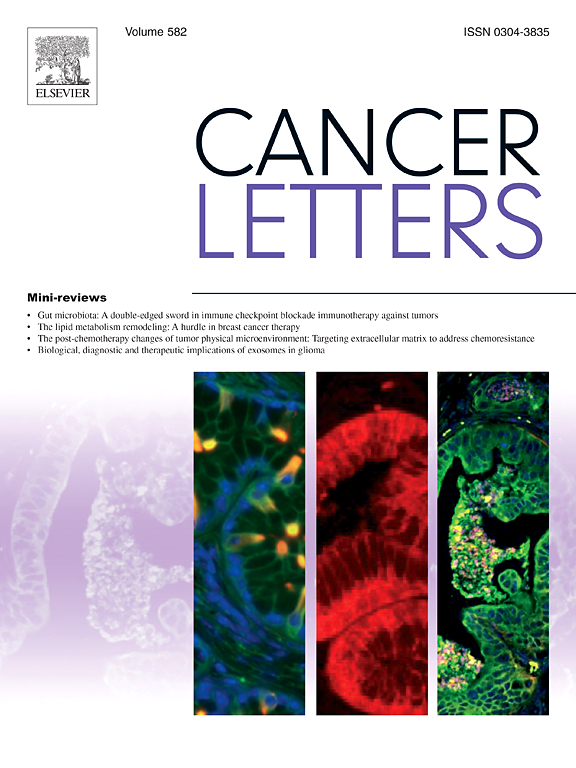CDYL2b在前列腺癌中的抗肿瘤活性
IF 10.1
1区 医学
Q1 ONCOLOGY
引用次数: 0
摘要
前列腺癌是男性死亡的主要原因,但这种恶性肿瘤的分子基础仍未完全了解。我们发现驱动前列腺肿瘤发生的两种组蛋白去甲基化酶,JMJD2A和JMJD2B酶,抑制CDYL2表观遗传解读基因的转录。生物信息学分析显示,前列腺肿瘤中CDYL2的低表达与更多的转移和疾病复发以及降低生存率相关。在四种预测的CDYL2亚型中,所有这些亚型都能够形成同异构体和异构体,只有CDYL2b在前列腺癌细胞中明显表达,并且与染色质密切相关。在人DU145和22Rv1前列腺癌细胞中,过表达CDYL2b可抑制其体外生长和克隆生成活性以及裸鼠肿瘤扩增,而下调CDYL2b可促进LNCaP细胞的生长。RNA测序结果显示,CDYL2b诱导了转录因子基因HES7、KLF17和TBX6的上调以及这些基因的过表达不同程度地表型复制了CDYL2b的抑癌作用。此外,JMJD2B,而不是JMJD2A,与CDYL2b形成强大的复合物,并在上调HES7转录中拮抗CDYL2b。总之,我们的数据强调CDYL2b可以抑制前列腺肿瘤的发生,而JMJD2A和JMJD2B可能部分通过抑制CDYL2b的转录或CDYL2b的活性来发挥其促癌功能。此外,我们的研究还揭示了发育转录因子TBX6和HES7也可能抑制肿瘤的发生。本文章由计算机程序翻译,如有差异,请以英文原文为准。
Anti-tumor activity of CDYL2b in prostate cancer
Prostate cancer is a leading cause of death among men, yet the molecular underpinnings of this malignancy are still not fully understood. We discovered that two histone demethylases driving prostate tumorigenesis, the JMJD2A and JMJD2B enzymes, suppressed transcription of the CDYL2 epigenetic reader gene. Bioinformatic analyses showed that low CDYL2 expression in prostate tumors was associated with more metastasis and disease recurrence as well as reduced survival. Out of the four predicted CDYL2 isoforms, all of which were capable of forming homo- and heteromers, only CDYL2b was appreciably expressed in prostate cancer cells and tightly associated with chromatin. Overexpression of CDYL2b in human DU145 and 22Rv1 prostate cancer cells decreased their growth and clonogenic activity in vitro as well as tumor expansion in nude mice, while CDYL2b downregulation stimulated LNCaP cell growth. RNA sequencing exposed that CDYL2b induced upregulation of transcription factor genes HES7, KLF17 and TBX6 and overexpression of those factors phenocopied to various degrees the anti-oncogenic effects of CDYL2b. Further JMJD2B, but not JMJD2A, robustly formed complexes with CDYL2b and antagonized CDYL2b in upregulating HES7 transcription. In conclusion, our data highlight that CDYL2b can suppress prostate tumorigenesis, while JMJD2A and JMJD2B may exert their pro-oncogenic functions in part through stifling CDYL2b transcription or CDYL2b activity. In addition, our study revealed that the developmental transcription factors TBX6 and HES7 may also suppress tumorigenesis.
求助全文
通过发布文献求助,成功后即可免费获取论文全文。
去求助
来源期刊

Cancer letters
医学-肿瘤学
CiteScore
17.70
自引率
2.10%
发文量
427
审稿时长
15 days
期刊介绍:
Cancer Letters is a reputable international journal that serves as a platform for significant and original contributions in cancer research. The journal welcomes both full-length articles and Mini Reviews in the wide-ranging field of basic and translational oncology. Furthermore, it frequently presents Special Issues that shed light on current and topical areas in cancer research.
Cancer Letters is highly interested in various fundamental aspects that can cater to a diverse readership. These areas include the molecular genetics and cell biology of cancer, radiation biology, molecular pathology, hormones and cancer, viral oncology, metastasis, and chemoprevention. The journal actively focuses on experimental therapeutics, particularly the advancement of targeted therapies for personalized cancer medicine, such as metronomic chemotherapy.
By publishing groundbreaking research and promoting advancements in cancer treatments, Cancer Letters aims to actively contribute to the fight against cancer and the improvement of patient outcomes.
 求助内容:
求助内容: 应助结果提醒方式:
应助结果提醒方式:


